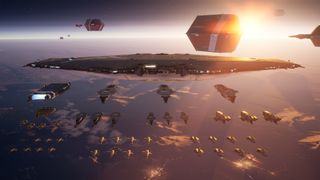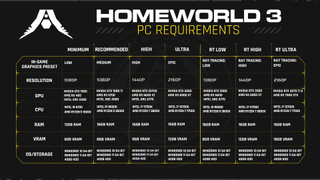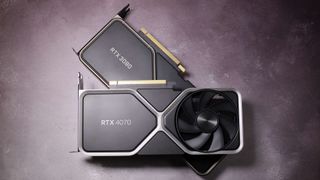Homeworld 3's latest system requirements won't fill up your SSD but you'll need all the CPU and GPU you can throw at it
Though a Ryzen 9 7700X an RTX 4070 Ti Super, for ray traced space battles in 4K, isn't too bad.

Update (May 03): This article has been updated to include a clarification from Homeworld 3's developers as to which version of DLSS the game will launch with.
With Homeworld 3 just weeks away from launch, Blackbird Interactive has done what surprisingly few developers do these days: updated and released a comprehensive system requirements chart. For gamers using a modest PC, it looks very promising, but if you're hoping to play it at 4K with maximum graphics, you're going to need some of the very best gaming hardware.
The chart was tweaked last week to "match the performance and optimization improvements made coming up to launch", which is May 13. I'm not a big fan of developers posting minimum requirements and much prefer to use their recommended specs as the entry point for enjoyable gameplay. For playing at 1080p, using the medium quality preset, a Core i5 9600K or Ryzen 5 3600X is suggested for the CPU.
| Header Cell - Column 0 | Minimum | Recommended | Ultra |
|---|---|---|---|
| In-game graphics preset | Low | Medium | Epic |
| Resolution | 1080p | 1080p | 2160p / 4K |
| GPU | Arc A380, GeForce GTX 1060, Radeon R9 480 | Arc A580, GeForce GTX 1080 Ti, Radeon RX 5700 | GeForce RTX 3080, Radeon RX 6900 XT |
| CPU | Core i5 6700, Ryzen 5 1600X | Core i5 9600K, Ryzen 5 3600X | Core i7 12700K, Ryzen 7 7700X |
| RAM | 12GB | 16GB | 16GB |
| Graphics card VRAM | 6GB | 8GB | 12GB |
| Storage | 40GB HDD | 40GB HDD | 40GB HDD |
| Operating system | Windows 10 /11 64-bit | Windows 10 /11 64-bit | Windows 10 /11 64-bit |
Those are both six-core processors, though AMD's does offer multithreading support for 12 threads in total. That Intel chip dates back to 2018 (the Ryzen is a year younger), which suggests that Homeworld 3 won't be especially CPU-heavy at low settings. However, it is a real-time strategy game set in space, so I should imagine that in really big battles, especially online ones, an i5 9600K might struggle a bit.
For graphics cards, Blackbird Interactive suggests an Arc A580, GeForce GTX 1080 Ti, or a Radeon RX 5700. The Nvidia recommendation is a seven-year-old GPU but at the time, it was one of the most powerful graphics cards you could buy. Today's mainstream GPUs are more than a match for it, so if you have a more recent GPU, that's what the devs are referring to. It does make a pleasant change seeing Intel's graphics cards getting a mention in system requirements.
RAM requirements are 16GB across the board and that's pretty much the norm for PC gaming these days. What is unusual is the amount of storage space needed, just 40GB. Compared to the 100GB+ behemoths we often see nowadays, that seems like a mere drop in the ocean. Mind you, space is mostly empty.
Going to the other scale of things, 4K gaming on the Epic preset needs far more recent and potent hardware. A Core i7 12700K or Ryzen 7 7700X for the CPU, and an RTX 3080 or RX 6900 XT for the graphics card. Those GPUs aren't the latest models, of course, but neither are they lightweight offerings. Blackbird Interactive also points out that you'll need 12GB of VRAM on your card with these settings.
The biggest gaming news, reviews and hardware deals
Keep up to date with the most important stories and the best deals, as picked by the PC Gamer team.
If you check out the full system requirements below, you'll see that no setting requires a more capable CPU than an i7 12700K or Ryzen 7700X.

The makers of Homeworld 3 explained why: "...due to the amount of physics and calculations happening throughout gameplay Homeworld 3 is CPU bound, not GPU bound. In terms of the way Homeworld 3 interacts with players CPU’s, we’ve found during development that core count doesn’t matter nearly as much as core speed. Six cores are the expected minimum, as the game routinely uses four fully. Essentially, more cores won’t necessarily translate to better performance."
With that all clarified, let's move on to the ray tracing requirements. There isn't much call for highly accurate global illumination in open-space games, so the developers are only using it for shadows. The system requirements for enabling ray tracing start very reasonably at 1080p, Low RT but jumps up to some pretty hefty components if you want to play at 4K, Ultra RT.

Best CPU for gaming: The top chips from Intel and AMD.
Best gaming motherboard: The right boards.
Best graphics card: Your perfect pixel-pusher awaits.
Best SSD for gaming: Get into the game ahead of the rest.
On maximum settings, the GPU requirement is an RTX 4070 Ti Super or RX 7900 XTX. That's obviously right at the high end of things but upscalers are on offer in the form of AMD's FSR 2, Intel's XeSS, and Nvidia's DLSS 2 (rather than DLSS 3, as initially reported) to claw back some performance, though there won't be any implementation of frame generation. Not for the game's launch, at least.
Fans of Intel's upscaler will be pleased to see that this is an option, but do note that it's the version that any GPU can run, rather than the Arc-dedicated system.
If I have one criticism of Blackbird Interactive's system requirements is that while they're pretty comprehensive, the chart says nothing at all about expected performance—in other words, what kind of frame rate should expect to see with that hardware and setting combination. One could take this as a sign that the game isn't going to run at very high fps but in RTS games, what really counts as high?
When Homeworld 3 launches on May 13, we'll be sure to let you know.

Nick, gaming, and computers all first met in 1981, with the love affair starting on a Sinclair ZX81 in kit form and a book on ZX Basic. He ended up becoming a physics and IT teacher, but by the late 1990s decided it was time to cut his teeth writing for a long defunct UK tech site. He went on to do the same at Madonion, helping to write the help files for 3DMark and PCMark. After a short stint working at Beyond3D.com, Nick joined Futuremark (MadOnion rebranded) full-time, as editor-in-chief for its gaming and hardware section, YouGamers. After the site shutdown, he became an engineering and computing lecturer for many years, but missed the writing bug. Cue four years at TechSpot.com and over 100 long articles on anything and everything. He freely admits to being far too obsessed with GPUs and open world grindy RPGs, but who isn't these days?
Most Popular






